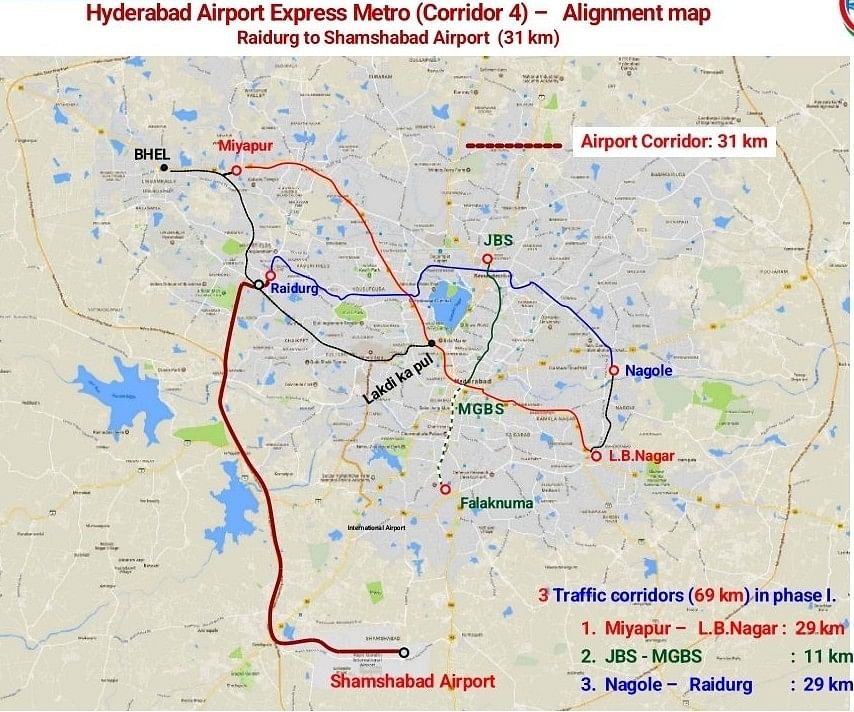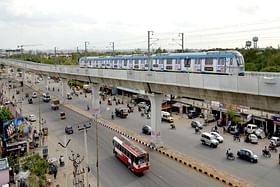At present, Hyderabad’s metro rail network spans over 69 km with three corridors criss-crossing the main city.
At a gathering of realtors, the Telangana Municipal Administration Minister, KT Rama Rao (popularly known as KTR), revealed the government’s ambitious plans for the future development of Hyderabad.
The Minister shared Chief Minister K Chandrashekar Rao’s vision of expanding the Metro network in Hyderabad to a staggering 250 kilometre.
Hyderabad Metro Rail (HMR), conceived to offer a world-class public transport system for Hyderabad city is a milestone project which is redefining the way in which commuters are travelling within the rapidly growing city.
During his speech, KTR highlighted several upcoming projects that will contribute to this expansion.
Expansion Plan
One of these projects is the new Airport Express Metro, a 31-kilometre stretch connecting Shamshabad to Raidurg.
The airport Metro, according to KTR, will not only benefit air travellers but also open up the southwest corridor of Hyderabad.
In addition to this, the Phase-II expansion of Hyderabad Metro Rail Limited from BHEL to Lakdi-ka-pul (26 kilometre) and Jubilee Bus Station to ECIL will also be added to the existing network of 71 kilometre.
The withdrawal of GO-111, which previously restricted development in the catchment areas of Osman Sagar and Himayat Sagar lakes, has now allowed for construction activities in the region.
Airport Metro — Rapid Connectivity to International Airport
The airport corridor will connect Mindspace junction near Raidurg Metro station and the city’s international airport located at Shamshabad after traversing along the Outer Ring Road (ORR) of the city.
The Airport Metro will connect the city to the airport and other major areas, such as the IT hub of Hitec City, Madhapur, Gachibowli, Nanakramguda, Narsingi, Kokapet etc.
Estimated to cost Rs 6,250 crore, the project is fully funded by the state government. The foundation stone for the project was laid by Telangana Chief Minister K Chandrasekhar Rao on 9 December last year.
The Airport Metro will reduce travel time from the city to the airport by up to 50 per cent. The metro is expected to take just 20 minutes to connect the airport to the main city.
Biodiversity junction, Nanakramguda, Narsingi, TS Police Academy, Rajendranagar, Shamshabad, Airport Cargo station and terminal are expected to be a few of the stations.
Phase-I metro
The Phase-I metro project was built under the public-private partnership mode, and a consortium of public-sector banks led by the State Bank of India had loaned around Rs 11,000 crore. This project is the only one of its kind in the country.
At present, Hyderabad’s metro rail network spans over 69 km with three corridors crisscrossing the main city.
There are three corridors:
- Corridor-I (Red Line) — Miyapur to LB Nagar (29 km; 27 stations)
- Corridor-II (Green Line) — JBS to MGBS (11.2 km; 10 stations)
- Corridor-III (Blue Line) — Nagole to Raidurg (29 km; 23 stations)

Hyderabad Before Metro
The population of Hyderabad is around 13 million. In order to address the growing public transportation needs and also to mitigate the growing road traffic in the twin cities of Hyderabad and Secunderabad, the state government of the time and the South-Central Railway had jointly launched the Multi-Modal Transport System (MMTS) in August 2003.
However, as Hyderabad continued to grow, the MMTS alone was not sufficient to meet the demands of public transport. Urban Development department approved the construction of the Hyderabad Metro Rail project.
Based on the traffic and transportation studies which were conducted by various agencies, the erstwhile Government of Andhra Pradesh approved the development of Hyderabad Metro Rail project in three high density traffic corridors of the city, in Phase-I.
Green Metro
The ‘green’ Metro project incorporates several positive aspects, such as rainwater harvesting for groundwater recharge, recycling 100,000 litre of water daily.
The Metro is estimated to eliminate 10,000 tons of carbon-di-oxide (CO2) emissions and 200 tons of volatile organic compounds, including 12 tons of particulate matter.
The utilisation of innovative rolling stock in the HMR project alone is expected to reduce 5,000 tons of CO2 equivalent emissions and eliminate $5 million in additional environmental damage costs.
The integration of solar energy further enhances the eco-friendliness of the Metro rail system. The presence of over a thousand trees in and around Metro rail depots contributes to a natural ambience and improved landscape.
The HMR also takes initiatives to recycle and reuse approximately one ton of waste paper annually, which saves an estimated 23 trees each year.
Furthermore, the use of eco-friendly chemicals for housekeeping and maintenance of artworks at Metro stations ensures minimal energy consumption.
Multi-Modal Connectivity
The metro rail project offers good connectivity at various points along the three corridors. The Hyderabad Metro Rail stations of Miyapur, MGBS, Secunderabad East, Koti, Dilsukhnagar, and Jubilee Bus Station provide connectivity for commuters who wish to utilise the intercity, inter-state and intra-state bus services with easy access directly from the metro stations.
It offers effective integration with existing Indian railways junctions at Secunderabad, Begumpet and Nampally so that the much-needed connectivity to some of the major railway stations is also fulfilled as part of the project.
HMR also offers link to MMTS services at its metro stations in Secunderabad, Bharatnagar, Begumpet, Khairatabad, Lakdi-ka-pul and Malakpet.


